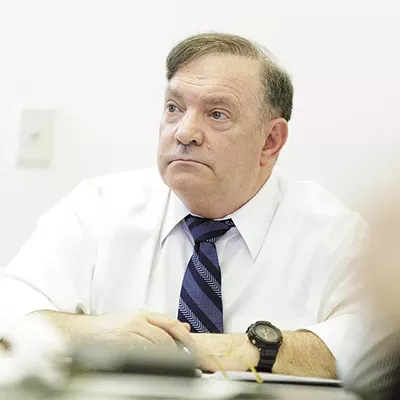"I can take off from the homestead and walk the beach for several miles before I get to any other habitation," says Sallee, a fisherman who also operates a small lumber mill. "There's two main mountain ranges on the island and a big valley of forest and muskeg."
Yet due to funds in a new transportation bill, which President Bush was scheduled to sign this week, Sallee and his neighbors may soon receive a bridge nearly as long as the Golden Gate Bridge and 80 feet taller than the Brooklyn Bridge. With a $223 million check from the federal government, the bridge will connect Gravina to the bustling Alaskan metropolis of Ketchikan, pop. 8,000.
"How is the bridge going to pay for itself?" asks Susan Walsh, Sallee's wife, who works as a nurse in Ketchikan. She notes that a ferry, which runs every 15 minutes in the summer, already connects Gravina to Ketchikan. "It can get us to the hospital in five minutes. How is this bridge fair to the rest of the country?"
The Gravina Bridge is one of a record 6,371 special projects, or "earmarks," in the Transportation Equity Act, a six-year $286 billion bill that rivals the recent energy bill in its homage to the pork barrel. No politician better flaunts an ability to bring home the bacon than Alaska's Don Young. As chairman of the House Committee on Transportation and Infrastructure, and Alaska's lone congressional representative for 32 years, the elder statesman wrangled $941 million for Alaska in the bill, making Alaska, the nation's third-least populated state, the fourth-biggest recipient of transportation funds. The money for the bill is fed by a gas tax at the pump, but this slush fund isn't redistributed to all Americans equally: The bill spends $86 per person on a national average; it spends $1,500 on every Alaskan.
"It seems to me that Don Young let his power go to his head," says Erich Zimmermann, senior policy analyst for Taxpayers for Common Sense. "It's out of control. Alaska manages to do well because Young and [Sen. Ted] Stevens are in positions to get lots of dollars, but it's taking advantage of the power they've been given. This bill is far too large at a time when deficits are supposed to be important."
Neither Young nor Stevens, chairman of the Senate Appropriations Committee, returned phone calls to comment on the projects. However, the two Alaskans, especially Young, have been loud and proud about their prowess to harness big bucks for transportation. They have repeatedly bragged that new roads and bridges will spur development and industry in Alaska. While speaking to a crowd in Ketchikan last year, Young referred to fellow Republican Stevens' prowess at rounding up pork, and said, "I'd like to be a little oinker myself." Young was so proud of the House version of the transportation bill that he named it TEA-LU, after his wife, Lu. He has said of the bill, "I stuffed it like a turkey."
Indeed. Included in the bill's special Alaska projects is $231 million for a bridge that will connect Anchorage to Port MacKenzie, a rural area that has exactly one resident, north of the town of Knick, pop. 22. The land is a network of swamps between a few hummocks of dry ground. Although it may or may not set the stage for future development, the bridge, to be named "Don Young's Way," will not save commuters into Anchorage any time, says Walt Parker, a former Alaska commissioner of highways.
"I wouldn't want the bridge named after me," says Parker, laughing. "Neither bridge makes much sense, but a lot of people are going to make a lot of money building the bridge, and then they'll have it, and it will have to be maintained. Alaska needs transportation money, but it needs to be spent in the right places."
Kevin McCarty, policy director of the nonprofit Surface Transportation Policy Project, based in Washington, D.C., says that spending money on projects that won't be widely used is irresponsible when the country has such urgent transportation problems. Throughout the nation, there are more than 160,000 bridges and 34 percent of roads that need repairs, according to the American Society of Civil Engineers. For $1 billion -- a little more than the amount headed to Alaska -- the United States could improve all the traffic lights in the country, reducing congestion by up to 40 percent, according to a 2005 report by the Institute of Transportation Engineers.
"All Americans are paying for that bridge in Alaska," McCarty says. "If America was sitting down to the make the most of our money, is that what we'd buy?" He adds that the average household in the country spends 20 percent of its income on transportation, and that spending more on expanding public transportation would "be a good investment before we just keep throwing money out the door." About 19 percent of the funds in the transportation bill are marked for public transit, a slight decrease from the amount authorized in the previous highway act of 1998.
While Young's haul for Alaska is a flagrant example of pork-barrel politics, it's indicative of what nearly all legislators do in an effort to get reelected, says Stephen Slivinski, an economist at the libertarian Cato Institute. New bridges and roads may be the stuff of campaign speeches, they aren't priorities for state highway departments, according to a 1991 Government Accountability Office report. "This shows what happens when Congress thinks it can make decisions better than folks at the local level," says Slivinski. "It's the worst way to create transportation policy. If you want to summarize this bill, any synonym of 'egregious' will do."
This article first appeared on & lt;a href="http://www.salon.com" & Salon & lt;/a & .
















